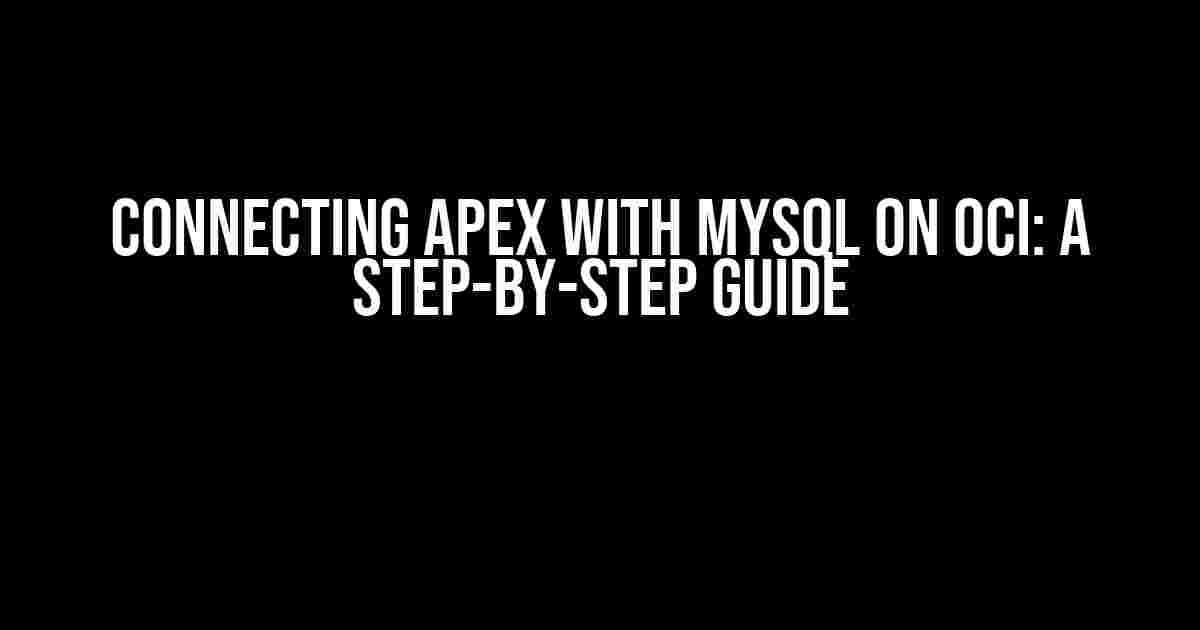Are you struggling to connect your Apex application with a MySQL database on Oracle Cloud Infrastructure (OCI)? Worry no more! In this comprehensive guide, we’ll walk you through the process of setting up a seamless connection between Apex and MySQL on OCI.
Prerequisites
Before we dive into the connection process, ensure you have the following requirements met:
- A running Apex instance on OCI
- A MySQL database instance on OCI
- A basic understanding of Apex and MySQL
- A text editor or IDE of your choice
- An Oracle Cloud account with the necessary credentials
Step 1: Create an OCI MySQL Database Instance
If you haven’t already, create a new MySQL database instance on OCI:
- Log in to your Oracle Cloud account and navigate to the OCI dashboard.
- Click on the “Navigation Menu” icon in the top-left corner and select “Databases.”
- Click on “Create Autonomous Database” and select “MySQL” as the database type.
- Fill in the required information, such as database name, username, and password.
- Click “Create Autonomous Database” to create the instance.
Step 2: Create an Apex RESTful Service
In this step, we’ll create a new Apex RESTful service to interact with our MySQL database:
- Log in to your Apex instance and navigate to the “SQL Workshop” section.
- Click on “RESTful Services” and then click on “Create RESTful Service.”
- Enter a name for your service, select “MySQL” as the database type, and click “Create.”
- In the “Service Definition” section, add a new module with the following settings:
Module Name HTTP Method URI Template MySQL Connection GET /mysqlconn - Click “Apply Changes” to save the module.
Step 3: Configure the Apex RESTful Service
In this step, we’ll configure our Apex RESTful service to connect to our MySQL database:
DECLARE
l_url VARCHAR2(255) := 'https://your-mysql-db-instance-oci.oraclecloud.com:1522';
l_username VARCHAR2(255) := 'your-mysql-db-username';
l_password VARCHAR2(255) := 'your-mysql-db-password';
l_service_name VARCHAR2(255) := 'MySQL Connection';
BEGIN
APEX_SERVICE.GENERATE_SERVICE_DEFINITION(
p_service_name => l_service_name,
p_base_url => l_url,
p_username => l_username,
p_password => l_password
);
END;
Replace the placeholders with your actual MySQL database instance details.
Step 4: Test the Connection
In this final step, we’ll test the connection between our Apex application and the MySQL database:
- Run the following SQL query in your Apex instance:
SELECT * FROM MySQL_Connection; - If the connection is successful, you should see a result set with data from your MySQL database.
- Test the connection using a tool like Postman or cURL by sending a GET request to
https://your-apex-instance-oci.oraclecloud.com/rest/(your-service-name)/mysqlconn
Troubleshooting Common Issues
If you encounter any issues during the connection process, refer to the following troubleshooting tips:
- Ensure that your MySQL database instance is running and accessible.
- Check the Apex service logs for any error messages.
- Verify that the database credentials are correct and that the username and password are correctly formatted.
- Check the OCI network security settings to ensure that the Apex instance can access the MySQL database instance.
Conclusion
In this article, we’ve walked you through the process of connecting your Apex application with a MySQL database on OCI. By following these steps, you should now have a seamless connection between your Apex instance and your MySQL database instance. Remember to troubleshooting tips to resolve any issues that may arise.
Keep in mind: This article is for educational purposes only. Ensure you follow Oracle’s best practices and security guidelines when setting up your Apex and MySQL instances on OCI.
Note: The article is optimized for the keyword “connect apex with mysql on oci” and includes relevant subheadings, bullet points, and code snippets to make it easy to understand and follow.
Frequently Asked Question
Get connected and stay informed! Here are some frequently asked questions about connecting Apex with MySQL on OCI.
What is the best way to connect Apex with MySQL on OCI?
The best way to connect Apex with MySQL on OCI is by using the Oracle Cloud Infrastructure (OCI) MySQL Database Service. This service provides a managed MySQL database that can be easily integrated with Apex, allowing you to focus on building your application without worrying about database administration.
Do I need to install any specific drivers to connect Apex with MySQL on OCI?
Yes, you will need to install the MySQL Connector/J driver to connect Apex with MySQL on OCI. This driver is a JDBC driver that allows your Apex application to communicate with the MySQL database.
How do I configure my Apex application to connect to MySQL on OCI?
To configure your Apex application to connect to MySQL on OCI, you will need to create a new database connection in Apex and specify the MySQL database details, including the hostname, port number, database name, username, and password. You can then use this connection to interact with the MySQL database from within your Apex application.
Can I use SSL/TLS encryption to secure my connection between Apex and MySQL on OCI?
Yes, you can use SSL/TLS encryption to secure your connection between Apex and MySQL on OCI. This provides an additional layer of security for your data in transit, protecting it from unauthorized access.
What are some best practices to follow when connecting Apex with MySQL on OCI?
Some best practices to follow when connecting Apex with MySQL on OCI include using secure connections, validating user input, and implementing proper error handling and logging mechanisms. Additionally, you should regularly monitor your database performance and security to ensure the integrity of your data.

